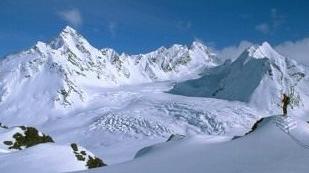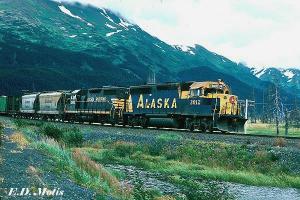|
Chugach Mountains
 The
Chugach
Range forms a 300-mile crescent located just outside the town of Valdez,
Alaska, east of Anchorage and west of the Wrangell Mountains. The climate
of the Chugach crest is strongly influenced by its position so near the
coast, and more snow falls here than in any other location in the world,
over 600 annual inches. The mountains are thickly forested with Western
Hemlock and Sitka Spruce. The peaks in the western half of the range originally
attracted little attention from mountaineers because of their relatively
low elevations, averaging less than 7,000 feet. Because of their nearness
to populated areas, however, their popularity has increased in recent times.
Since 1991, the World Extreme Skiing Championships have been held in the
range, an annual Spring event in which skiers challenge the steep, rugged,
undeveloped slopes. The highest peaks of the Chugach are located
in the central to west-central portions of the range, which extends to
the Tana River, Tana Glacier, and the Bering Glacier. The
Chugach
Range forms a 300-mile crescent located just outside the town of Valdez,
Alaska, east of Anchorage and west of the Wrangell Mountains. The climate
of the Chugach crest is strongly influenced by its position so near the
coast, and more snow falls here than in any other location in the world,
over 600 annual inches. The mountains are thickly forested with Western
Hemlock and Sitka Spruce. The peaks in the western half of the range originally
attracted little attention from mountaineers because of their relatively
low elevations, averaging less than 7,000 feet. Because of their nearness
to populated areas, however, their popularity has increased in recent times.
Since 1991, the World Extreme Skiing Championships have been held in the
range, an annual Spring event in which skiers challenge the steep, rugged,
undeveloped slopes. The highest peaks of the Chugach are located
in the central to west-central portions of the range, which extends to
the Tana River, Tana Glacier, and the Bering Glacier.
 Chugach
State Park, authorized in 1970 by the state legislature, is the second
largest of Alaska's state park units and, in fact, one of the largest state
parks in the country. (Wood-Tikchik State Park, near Dillingham in Southwest
Alaska, at over 1.5 million acres, is the largest state park in Alaska
and the US.) The park is situated in the extreme western end of the Chugach
Mountains and forms a wilderness buffer to the city. The park's approximately
495,000 acres of rugged terrain, which can change in relief as much as
5,000 feet within a mile, offer stunning views of Anchorage and points. Chugach
State Park, authorized in 1970 by the state legislature, is the second
largest of Alaska's state park units and, in fact, one of the largest state
parks in the country. (Wood-Tikchik State Park, near Dillingham in Southwest
Alaska, at over 1.5 million acres, is the largest state park in Alaska
and the US.) The park is situated in the extreme western end of the Chugach
Mountains and forms a wilderness buffer to the city. The park's approximately
495,000 acres of rugged terrain, which can change in relief as much as
5,000 feet within a mile, offer stunning views of Anchorage and points.
The Chugach National Forest is still
the second largest Forest in the National Forest System. Roughly the same
size as the states of Massachusetts and Rhode Island combined, the
Chugach is the most northern of National Forests, only 500 miles south
of the Arctic Circle. One third of the Chugach is composed of rocks and
moving ice. The remainder is a diverse and majestic tapestry of land, water,
plants and animals. The mountains, lakes, and rivers of the Kenai Peninsula,
the islands and glaciers of Prince William Sound, and the copious wetlands
and birds of the Copper River Delta make this National Forest a mecca for
adventurers. The Forest is widely known for its robust salmon fishing,
along with Dolly Varden, lake and rainbow trout, and others species.

City of Anchorage surrounded by the Chugach Mountains
Back
Page created 12/1/99 and last updated 5/12/25
|